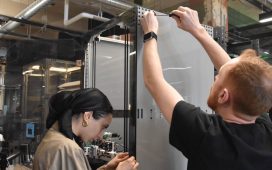Hexagon, a Stockholm-based firm that focuses on breakthrough technologies in autonomous and digital reality, has decided to ramp up its operations in India.
Currently, the €5.3 billion revenue firm has its largest global software and R&D facility in Hyderabad and going forward, the company will be diversifying into hardware systems in India to cater to various industries including automotive, oil & gas, power, aerospace, mining, infrastructure, utilities, smart cities, agriculture and defense, Navaneet Mishra, Senior Vice President & Head of Hexagon’s R&D Centre in India told The Hindu.
“I am looking forward to diversifying our work further to go beyond software development and solutioning to hardware system level programming in the near future. The diversification will be to go beyond software to also work on hardware system-level programming and similar such areas,” he said.
Mr. Mishra said Hexagon’s R&D in India was the single largest such facility globally with over 2,000 engineers, technologists and solution makers who are working on breakthrough innovations in products and platforms. Interestingly, India was the hub to deliver R&D for all of Hexagon’s business units. “Over the last 10 years, Indian operations have grown in scale with a diversified talent pool and therefore aligning with Hexagon’s global R&D vision.”
According to him, Hexagon technologies touched 75% of all cars, 90% of all aircraft built and 85% of all smartphones produced in the world. The company has delivered safer, reliable autonomous driving research vehicles than any other company in the world. Over 50% of all geospatial imaging and processing in the world today happens on Hexagon’s technologies and over 1 billion people are protected by Hexagon’s public safety solutions, he claimed.
Commenting on the importance of digital twin technology in the automotive space, Mr. Mishra said, the future of automotive manufacturing would be defined by the depth and precision of Digital Twin technologies. These twins would not only have to get precise dimensions and accurate placement of all parts – but they would need to be able to simulate all physical laws and material composition details for various scenarios. “We know that among automotive makers, whoever can make digital twins of machines quickly and accurately and then simulate the production processes and end-products in a gamut of real-world scenarios will emerge as the winner. Such production will be much more cost-efficient by saving on material wastage and physical iterations, and environment friendly,” he added.
month
Please support quality journalism.
Please support quality journalism.






